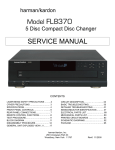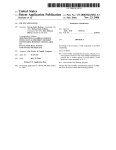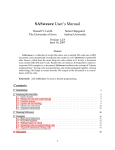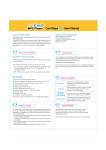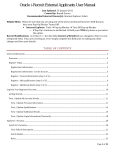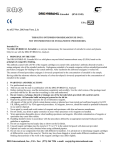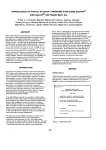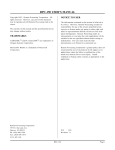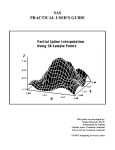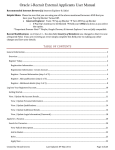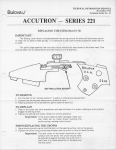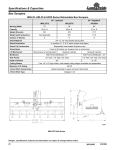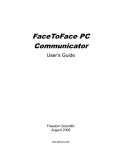Download Sugi-84-99 Roesti Ac..
Transcript
MANAGING HUMAN RESOURCES INFORMATION: USING THE SAS AND SAS/FSP PRODUCTS Paul Roesti, Joel Achtenberg, and Douglas G. Fishel Washington University in St. Louis Abstract Some of the most important data obtained are applicants' self-rated levels of skill for 211 skills. For each skill, applicants indicate one of the following: 1) I consider myself proficient with this, 2) I have done this occasionally, 3) I have never done this, but I have some knowledge or understanding of the principles involved, 4) I am not at all familiar with this, or 5) r do not want to be considered for a position which would reqUire me to do this. The skill-level data and other information from the application process is then entered into the HRMS. A Human Resources Management System (HRHS), under development for the Personnel Department Washington University School of Medicine at the in St. Louis is described. The primary function of the system is to match applicants with employer requirements. A pool of applicants is created, composed of potential employees. The pool contains applicants' skill levels for 211 skills, in Departments ask the Personnel Department for assistance in locating qualified applicant8 to fill their needs by submitting a job requisition fonn. Two different forms are used, a Technical and a General Requisition. Together, these two forms contain the same 211 skills listed on the applicants' Skills Data Sheet. addition to standard application data. Employers specify minimum levels acceptable for these same skills on job requisitions. The applicant a skills meeting or exceeding the requisition levels. Personnel staff may interactively relax or strengthen the search criteria. Potential employees are identified, and records of all referrals to employers and employers' decisions are kept for each applicant. When applicants are hired, they are added to an Employee Skills Data Bank. requisition pool to identify is searched using candidates with Employers indicate skills and the ffi1n1mum level of skill required with the following scale: 1) frequently done-we need 8omeone proficient with this, 2) occasionally done-we need someone who has done this occasionally, 3) willing to train-We need someone who can do this, but initially no ability is required. The requisitions are sent to the Personnel Department through campus mail service, and entered into the The system is interactive and menu-driven, using SAS modules under the control of an EXEC2 main module. Data entry is accomplished with FSEDIT. The Applicant Pool and Skills Data Bank are queried through FSBROWSE. Standard and ad-hoc report generation will be supported. HRMS. The HRMS is then used to find applicants that meet or exceed employers requisitions. By selecting a menu option to match applicant and requisition skills, all qualified applicants in the Applicant Pool are identified. Depending on the number of applicants selected (too few, or too many), Personnel Department staff may tighten or relax the matching requirements, and re-run the option. Techniques for using SAS and SAS/FSP in the CMS environment are presented, focusing on the following topics: 1) system access, secarity, and monitoring, 2) EXEC2 and SAS interfaces, 3) screen design, and 4) user education. Applicants selected are referred to employers for further consideration and interviews. A complete package of application data is provided, including applications for employment and applicants' resumes. System Overview The HRMS is designed to be the primary means of identifying applicants qualified for employment by Washington University School of Medicine departments. Initially, applicants complete a battery of forms and are interviewed by the Personnel Department. A Referral Form is also sent with each applicant package. When departments have completed reviewing the applicant, the form is returned to the Personnel Department. These forms, giving the results of the department's review. either hired, not hired-interviewed, not hired-not interviewed, are entered into the HRMS. SAS, and SAS/FSP are reBist~r~d trademarks of SAS Institute Inc., Cary, NC, USA. 536 When an applicant is selected for employment, their skills data is added to the HRMS Employee Skills Data Bank. Personnel Department staff simply select the appropriate menu option for loading this information. Access mode, also part of the CP LINK command, guarantees the integrity of the system. The 'R' mode, read only (R/O) , is used as the access mode for Userl and User2 links to the system disk. This mode allows access only if the System or Input/Edit Machines do not have the system disk in write status. System Access, Security, and Monitoring This would occur if the System Machine's master data libraries were currently being updated by the Input/Edit Machine. As shown in Figure I, the Input/Edit Machine has WR (Write/Read) access to the system disk. WR access supports write access only if Use~l and User2 do not have the system disk in read status; then an a alternate access of read only is given. Human Resource information must be treated as sensitive data. The Personnel Department was especially concerned about the protection of applicant information. Four CMS Virtual Machines are utilized in the HRl1S system configuration. One machine (the System Machine) is used by our programming staff. The primary disk space (A disk) on this machine is used as a 'system' disk. The different SAS modules, screen data sets , and the EXEC2 file which drives the HRMS are maintained here, as well as master and backup copies of SAS data libraries. When the access mode requested at logon cannot be granted, a message is displayed and the system automatically takes the appropriate action. For instance, suppose Userl attempts to run the matching routine (an R access to the system disk) while the Input/Edit Machine is updating the master files (WR access to the system disk). The message 'FILES CURRENTLY BEING UPDATED -- TRY AGAIN SHORTLY' is displayed, and the Userl Machine is logged off. The other three virtual machines belong ·to the Personnel Department. One machine (the Input/Edit Machine) supports all of the system's functional capabilities, but is used primarily for data entry and editing. The remaining two virtual machines (Userl and User2) are restricted to running the matching routine, making queries, and producing reports. Of course, the eMS Userid and Password offer a minimal amount of protection. Additional security was built into the HRMS by prompting for a 'user' password (usually a person's first name) after successful logon. User passwords are changed by our staff an a regularly scheduled basis, or at the discretion of the Personnel Department. This configuration is accomplished by assigning access mode passwords to the System Machine's A disk. These passwords, when used with a CP LINK command in each of the Personnel Department machines' PROFILE EXEC, makes the System Machine's disk available. The machines are linked to the system disk as illustrated in Figure 1. Figure 1: Trying an unauthorized password results in an immediate logoff. Once a user has gained entry to the system, their activities are conditioned by their authorization. For instance, certain names are only allowed access to the database for queries; FSBROWSE supports their needs. Other userS are authorized to input, update and query; modules with FSEDIT gives these users access. CMS Virtual Machin" Configuration and System Disk A~ce8a The HRMS not only checks for user passwords. A log of successful and unsuccessful access attempts is maintained. The EXEC2 predefined variables &DATE and &TIHE are very useful for this purpose. By spooling console output on and off at appropriate times, system access is monitored. A message is also logged when an authorized user enters and exits a menu option. In between these messages, impo~tant segments of the SAS SASLOG are retained. At the end of the main module, just prior to logoff, the console log is punched to the user machines virtual reader. Sys~em Ma~~1ne Dhk , Access A~ceas EXEC2 and SAS Interfaces Note: Syst~m A single CMS EXEC controls program flow in the HRMS. This EXEC is initiated at the very end of PROFILE EXEC, which is automatically executed at logon. Mad\:.ne's RR Access To The Other A ll1.sks ~ot Lnd1cated. i'Ia~hin"s' 537 Using this means of controlling the HRMS has several advantages. One of the main benefits is the ability to inte~sperse communications with users, calls to the different SAS sub-modules, and CP and CMS commands in one source file. The two job requisition forms used in the system each require three screens for display. The Referral Form sent to employers is easily displayed on one screen. Menus, allowing users <0 select options. are easily displayed. This is accomplished with the &BEGmE command and inserting the menu text as it will appear on the screen. Two important considerations repeatedly surfaced during screen design: 1) accurate replication of a form on the video display, and 2) adding information to aid data entry. These considerations often resulted in a trade-off; doing one precluded addressing the other. By reading the selection entered with &READ followed by several &GOTO statements, the EXEC branches to an appropriate section of EXEC code. For instance, if a '1' is entered, the EXEC branches to the label, -APPLICATION. The screens for en~ering application forms are then genera~ed by calling SAS EXEC with an argument of APPLCANT. SAS is executed with NODATE and NONOTES options to minimize the appearance of unnecessary messages on the screen display. Space on a single screen display was the factor limiting the ability to address both concerns. Often times there was not enough room to closely reproduce a form or form section and include data entry prompts. We simply used onr judgement; generally, preference was given to making the screen look like the sonrce document. Designing forms to conform to FSP cursor movement is advisable. On several HEMS source documents, checklists of skills are completed by moving down columns, and then across the form. For example, applicants give skill levels on the Skills Data Sheet for Clerical-Secretarial and Office Machine skills by going down column 1, and then move to column 2 to indicate Administrative/Managerial, Professional Field, and Specialty skills. APPLCANT is the name of a file with a filetype of SAS containing the PROC FSEDIT source for the appropriate data and screen datasets. The procedure is called using OPTION=l, so that the first screen for data is immediately displayed, instead of the FSEDIT primary option menu. PROC FSEDIT has control until the user presses PF3 to end. Control then returns to the main EXEC, and an &GOTO -MAIN MENU command is issued. The EXEC branches back to-the &BEGTYPE containing main menu text, which is displayed on the screen. Our FSP screen datasets transpose this organization" presenting checklists for each job category as the cursor moves across rows and then down the screen. While this has not been a serious problem, the time required for data entry would pr.obably be less using a common movement pattern .. The user may select another option, and similar EXEC, SAS interfaces occur. If RETURN is pressed to end the session, the EXEC issues a CP LOGOFF command. User Education The HRMS is always under the control of the main EXEC, from session beginning to end. Users are never given the opportunity to issue commands in CP or CMS mode. We have enjoyed a friendly relationship with the users in the Personnel Department. Every effort has been made to inform them through formal presentations, training seSSions, written documentation, and on-line assistance. Screen Design New users of automatic data processing are anxious about information systems. One of their concerns is the retention of crucial data beyond their field of vision. We addressed this need by generally explaining the system's hardware configuration. Seven forms are used as source documents for the HRMS. Applicant related forms include an Employmen~ Application, Staff Affirmative Action Data Card, Interview Evaluation, and Skills Data Sheet. Nine screens were needed to accommodate the four applicant forms. All four of these forms are presented when the option to enter applicant data is selected from the main menu. The functional capabilities of the system were introduced as tasks to be performed. For example, users with full access may wish to: 1) entel' application furms, 2) enter lechnical requisitions, 3) enter general requisitions, 4) match applications and requisitions,S) enter referral forms, or 6) add new employees to the Employee Skills Data Bank. These tasks became options displayed on the main menu after logon. The inclusion of four different forms under a single option for entering applicant data affected screen design. In one instance, data items from two different forms, the Staff Affirmative Action Data Cacd and the Interview Evaluation, appear on the same screen. This screen was formatted to indicate which data items referred to a particular form. Full descriptions of each option are provided on-line. From the main menu, entering '?' displays these descriptions. Pressing RETURN gets the user back to the main menu. 538 A common nomenclature for FSP screen displays has been valuable. Vocabulary was established for severa 1 important concepts. One useful convention has been to differentiate data items (the prompt displayed), system data item names (SAS variable names), data item fields (the spaces provided for entering data), and data values (data occupying item fields). Interchangeably referring to data as records and ob~ervatinns required clarification. The manner in which a SAS dataset observation numbe~ changes for a given record due to record additions and deletions was also emphasized. Data file structure and its presentation through FSP screens were also important concepts. The difference between moving from screen to screen (lpft Hnrl right) and from observation to observation (forward and backward) was graphically presented. Personnel Department staff were schooled on use of the terminal devices supporting the HRMS. FSP PF key definitions and control code functions were explained. A User's Manual was written. The manual covers several topics, ranging from establishing communication (logon procedure) to locating an observation. Detailed appendices were included in the User Manual. One of the most important appendices is a Data Dictionary, listing SAS variable names and labels by screen location. The dictionary was created using the SAS listing from PROC CONTENTS and tailoring the output with a text editor. We wish to acknowledge and thank J.L. Midkiff, Gene Mueth, Lois England, and the entire School of Medicine Personnel Department Staff for their contributions to and support of the Human Resources Management System. For further information, contact Paul Roesti WU Medical School Box 8019 660 South Euclid St. Louis, Missouri 63110 314-362-2584 539





